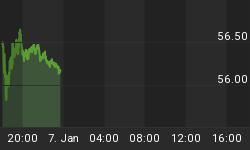The article below originally appeared at Treasure Chests for the benefit of subscribers on March 9th, 2006.
Due to a flu, this report is out slightly late today. Nothing has changed with the analysis, as you will see. The market is sitting on a fence and must decide which way to fall. I used candles in this chart to illustrate a potential reversal in the trend yesterday, denoted with the red circle. Blue lines on the right hand side represent Fibonacci price retracements of the move up in February. The 61.8% level was precisely hit, followed by a reversal (hammer). The lower Bollinger bands are in a consolidation phase and likely could see the markets sit in the range of 1260-1300 for another 2-3 weeks before breaking higher. As per the HUI, the markets often enter a period where it is difficult to forecast with certainty. The short-term stochastics have the %K beneath the %D and until it reverses and crosses above it, a sell signal remains intact. The HUI broke below 295 as mentioned yesterday and took a dive to 282 intraday. There is still a chance the HUI is going to 270 on this move down, so as mentioned one month ago, do not add to any further positions unless one is comfortable with their investment choice.
Figure 1
Fibonacci price projections are shown in red on the right hand side of the chart, based on upward trending wave price action projected off their subsequent lows. Areas of line overlap form Fib clusters, which represent important support/resistance levels. Resistance is currently present at 1280, with strong support at 1259. Figure 4 shows the mid-term Elliott Wave count of the S&P. Full stochastics have the %K above the %D, but appears set to curl beneath it. Wedges in the stochastics suggest that a decline could continue for 2-3 weeks; a break in the lower trend line would only exacerbate the downward trend. Based upon the heavy topping action, it suggests one more leg is required to complete the pattern. Today's action is supportive of an upward move, but to confirm the upward trend, refer to Figure 4.
Figure 2
The weekly S&P chart is shown below. A Babson channel contains the index footprint since mid 2002. The lower 21 MA Bollinger band just turned up, suggestive further upside is required before a top is put in. As I always mention, notice how the S&P has been moving within Fib channels since late 2003. This kind of behaviour suggests the mathematics of the market are under control and a test of the upper Fib channel (at 1262) is minimally expected in this move. Full stochastics have the %K nearly 1 point lower than the past week. Since the wedge in the stochastics has been in place since mid 2002, it is highly probable that the S&P will remain buoyant for another 2-3 months or until the %K is near the apex (of the wedge) before turning down. As per last weeks update of the TNX, a move to 5.4% can minimally be expected by May or June this year. The markets do not function on rational behaviour, so expect the unexpected. I am not sure if a negative divergence in the full stochastics will occur near the top, but if it does happen, then 1-2 months subsequently will be a top. Should the S&P hit 1400-1450, a retracment back down to 1070 is expected by late 2007. This will be the turning point for the final upward move in the S&P into 2009/early 2010 (a top near 1600-1700 due to oil and gold stock weightings) before everything heads south. This will include most commodity stocks also. This time next year when your friends and family notice that your commodity stocks have done well, it will be seen in disbelief, followed by a fear of not participating and losing out on an easy retirement. When the top in oil and gold stocks occurs, it will be unmistakable. There will be no room for a margin of error. The daily articles I put out not only help the reader, but myself included. I get the opportunity to learn the more I analyze and I thank everyone for the opportunity to do so. The next Figure is the most important of the bunch, so lets get to it.
Figure 3
The mid-term Elliott Wave count of the HUI is shown below. As mentioned in Figure 1, the wave up in February was retraced precisely to 61.8%. This was either wave [i].C or a decline to 1250 can be expected in the HUI to complete wave [c].B. A move in the S&P to 1301 is a buy signal for calls. A bottom at 1250 is a buy signal for calls. Let the market decide what it is going to do, because either scenario is probable. The S&P pattern has been a tricky beast the past 3 years, but it had a recognizable pattern that defined the move. A lot of people are shorting the market and when it reverses, many will be burnt. When a top is placed in the S&P in the next 2-3 months, there will not be many people shorting the market, so expect a very sharp decline at that point in time. Watch the tape carefully: a sharp rally in the S&P indicates the upward trend is in force. When the decline in the markets does occur, gold and oil stocks are expected to fall in sympathy, only to reverse course and rise to the shock of many.
Figure 4
Well, that is all for early this morning. I will update the TNX for Friday AM. Not much to report on it........still going to 5.4%.















